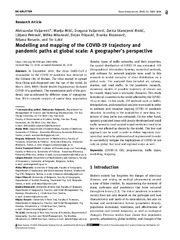Приказ основних података о документу
Modelling and mapping of the COVID-19 trajectory and pandemic paths at global scale: A geographer's perspective
| dc.creator | Valjarević, Aleksandar | |
| dc.creator | Milić, Marija | |
| dc.creator | Valjarević, Dragana | |
| dc.creator | Stanojević-Ristić, Zorica | |
| dc.creator | Petrović, Ljiljana | |
| dc.creator | Milanović, Miško | |
| dc.creator | Filipović, Dejan | |
| dc.creator | Ristanović, Branko | |
| dc.creator | Basarin, Biljana | |
| dc.creator | Lukić, Tin | |
| dc.date.accessioned | 2021-09-24T15:46:12Z | |
| dc.date.available | 2021-09-24T15:46:12Z | |
| dc.date.issued | 2020 | |
| dc.identifier.issn | 2391-5447 | |
| dc.identifier.uri | https://gery.gef.bg.ac.rs/handle/123456789/1067 | |
| dc.description.abstract | In December 2019, the virus SARS-CoV-2 responsible for the COVID-19 pandemic was detected in the Chinese city of Wuhan. The virus started to spread from China and dispersed over the rest of the world. In March 2020, WHO (World Health Organization) declared COVID-19 a pandemic. The transmission path of the pandemic was accelerated by different types of transportation. With complete analysis of spatial data, population density, types of traffic networks, and their properties, the spatial distribution of COVID-19 was estimated. GIS (Geographical Information System), numerical methods, and software for network analysis were used in this research to model scenarios of virus distribution on a global scale. The analyzed data included air, railway, marine, and road traffic. In the pandemic research, numerous models of possible trajectory of viruses can be created. Many have a stochastic character. This study includes all countries in the world affected by the COVID-19 up to date. In this study, GIS methods such as buffer, interpolations, and numerical analysis were used in order to estimate and visualize ongoing COVID-19 pandemic situation. According to the availability of new data, trajectory of virus paths was estimated. On the other hand, sparsely populated areas with poorly developed and small traffic networks (and isolated island territories) tend to be less or not affected as shown by the model. This low-cost approach can be used in order to define important measures that need to be addressed and implemented in order to successfully mitigate the implications of COVID-19 not only on global, but local and regional scales as well. | en |
| dc.publisher | De Gruyter Open Access | |
| dc.rights | openAccess | |
| dc.rights.uri | https://creativecommons.org/licenses/by-nc-nd/4.0/ | |
| dc.source | Open Geosciences | |
| dc.subject | COVID-19 | en |
| dc.subject | GIS | en |
| dc.subject | progressions | en |
| dc.subject | traffic types | en |
| dc.subject | modelling | en |
| dc.subject | mapping | en |
| dc.title | Modelling and mapping of the COVID-19 trajectory and pandemic paths at global scale: A geographer's perspective | en |
| dc.type | article | |
| dc.rights.license | BY-NC-ND | |
| dcterms.abstract | Ваљаревић, Aлександар; Басарин, Биљана; Милановић, Мишко; Филиповић, Дејан; Станојевић-Ристић, Зорица; Ваљаревић, Драгана; Петровић, Љиљана; Лукић, Тин; Ристановић, Бранко; Милић, Марија; | |
| dc.citation.volume | 12 | |
| dc.citation.issue | 1 | |
| dc.citation.spage | 1603 | |
| dc.citation.epage | 1616 | |
| dc.citation.other | 12(1): 1603-1616 | |
| dc.citation.rank | M23 | |
| dc.identifier.wos | 000609186700001 | |
| dc.identifier.doi | 10.1515/geo-2020-0156 | |
| dc.identifier.scopus | 2-s2.0-85099098916 | |
| dc.identifier.fulltext | https://gery.gef.bg.ac.rs/bitstream/id/62/1065.pdf | |
| dc.identifier.rcub | https://hdl.handle.net/21.15107/rcub_gery_1067 | |
| dc.type.version | publishedVersion |


